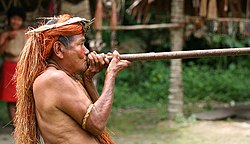Yagua people

Yagua man demonstrating the use of a punaca at one of the Amazonian islands near Iquitos
|
|
| Total population | |
|---|---|
| (6,000 (2000)) | |
| Regions with significant populations | |
|
|
|
| Languages | |
| Yagua, Spanish | |
| Religion | |
| traditional tribal religion, Christianity | |
| Related ethnic groups | |
| Yameo people |
Yagua people are an indigenous people in Colombia and northeastern Peru, numbering approximately 6,000. Currently, they live near the Amazon, Napo, Putumayo and Yavari rivers and their tributaries. As of 2005, some Yagua have migrated northward to Colombia, near the town of Leticia.
Currently the Yagua live in some 30 communities scattered throughout a section of the Peruvian and Colombian Amazon basin which can roughly be described as a rectangle 200 miles wide and 350 miles long (70,000 sq. miles) extending southward from the second to the fifth parallel and westward from the 70th to the 75th meridian west.
The Yagua language is classified as a Peba-Yaguan language. The only closely related languages that have been documented are Peba and Yameo both of which are now extinct.
2000 Yagua people in Peru were monolingual in 2000, and of these, 75% were women and 25% were men. The majority of the rest are bilingual in Spanish to varying degrees.
Yagua people are also known as Llagua, Nijyamïï Nikyejaada, Yahua, Yava, and Yegua.
There are two possible etymologies for the term 'Yagua', both of which originate outside of the Yagua language. First, the Quechua term yawar meaning 'blood' or 'the color of blood', is a likely possibility due to the Yagua custom of painting their faces with achiote, the blood red seeds of the annatto plant (Bixa orellana).
...
Wikipedia
